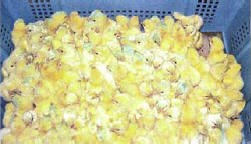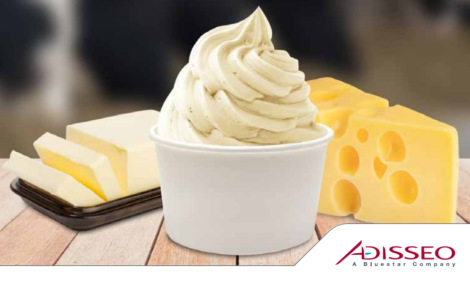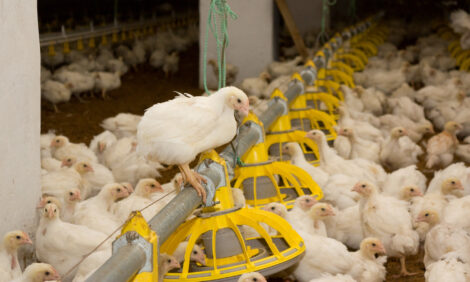



The Importance Of Temperature Control In Optimising Chick Health
By Ron Meijerhof, Senior Technical Specialist, Hybro B.V., Boxmeer, The Netherlands and Danuta Furmanek, technical manager poultry products, Intervet International B.V. - Chicken embryos and newborn chicks are extremely sensitive creatures, especially in regard to environmental temperatures. Low temperatures, including those resulting from spray vaccination, may have a dramatic effect on the birds’ feed intake and stimulation of the immune system.
Chickens are homeotherm, which means that within limits, they can regulate their own body temperature, much as mammals do. However, they are not born that way. During the embryonic phase, chickens are poikilotherm, which means that their body temperature follows that of their environment, as in reptiles. The difference with reptiles is that they can function properly at a wide range of body temperatures: they simply adjust their metabolism to it. Chickens achieve ideal development at optimum body temperature, but in the poikilotherm stage they cannot maintain that temperature themselves.
This phenomenon is well known in incubation. We set the temperature in the incubator very precisely to bring the embryos exactly to optimum temperature. In an ideal situation, heat production by the embryo, heat loss from the egg and the environmental conditions are so well balanced, that the temperature of the embryo stays exactly at its optimum. Optimum embryonic temperature is acknowledged to be between 100.0 - 100.5°F, measured as egg shell temperature, as this accurately reflects the temperature of the embryo. We control the incubation process by checking the temperature of the shell with an infrared ear thermometer and adjusting incubator conditions to achieve the optimum heat balance.
We also know that in chickens, this is much less critical. If temperature is not exactly in balance with the heat production of the bird, the bird will not immediately reflect that in its body temperature. However it will pay a price for keeping its body temperature more or less constant, either by having to use more feed for heat production or by limiting its feed intake to reduce heat production, but the direct effect is not as dramatic as in embryos.
The critical transition time
For the embryo, the process of changing from poikilotherm to homeotherm takes five or six days - starting at day 19 of incubation and completing when the chick is four to five days old. In chicks from young breeder flocks, this process can take 24 to 48 hours longer. It actually means that day-old chicks’ ability to regulate or maintain its temperature is as immature as an embryo’s, and if conditions are not optimal, its body temperature can drop dramatically. Within two hours following placement, a day-old chick’s body temperature can drop more then 5°C, from the optimal level of 40°C to 35°C or lower. In some circumstances body temperatures as low as 33°C have been found, without the bird actually dying - at least not immediately.
We control the body temperature of a day-old chick mainly by controlling heat loss through the floor. If the house is on temperature but the floor is too cold (below 29-30°C), the birds lose too much heat through their feet, lie down and become even colder because now a larger body area is touching the floor, and their body temperature will drop very quickly. It is clear, therefore, that maintaining the correct air temperature is not enough to prevent this heat loss: it’s exactly the same principle as when we as humans walk barefoot over a cold floor.
Consequences of low temperature
The consequences of this drop in body temperature are quite dramatic. Although day-old chicks are able to deal with a relatively large range of body temperatures, as are all newborn animals, they will - if the correct body temperature is not restored quickly - experience difficulties.
The first reaction of the chick will be to start making noise, to attract the attention of mother hen and to tell her that it needs support. If, in our chicken houses, mother hen doesn’t respond and the temperature drops further, the bird will become under-cooled and start to lie down, which further accelerates the process of becoming under-cooled. An under-cooled bird will experience stress, which prevents its immune-system from functioning properly, leaving it more susceptible to e-coli or any other type of bacterial infection. In these circumstances, first week mortality will inevitably be increased.
By lying down, the chick will also not find feed and water, as in a normal process it “stumbles” into it when moving around. These “non-starters” will not digest any feed in that first hours/days, so they will also not obtain any heat from the digestion process. By not eating, the digestive tract is not stimulated, and the immune-system is not stimulated either. When the birds don’t eat, they don’t take up carbohydrates, and these carbohydrates are needed to absorb the yolk residue.
Without eating, the residual yolk will remain longer in the body cavity, increasing the risk of navel-yolk sac mortality. And in this yolk, mother hen stored her maternal anti-bodies. If the chick is unable to take up the yolk properly because it lacks the carbohydrate energy produced by eating, it will also have reduced access to the benefits of these maternal antibodies.
Last but not least, the consequences for the performance of the flock are significant. The problem is not so much increased mortality in the first week, which although regrettable, is a relatively inexpensive mortality. However the birds that were under-cooled but didn’t die are more of a concern. These birds will not start for a couple of days, and remain at hatch weight when the rest of the flock is already up to a body weight of 120-150g. Not only will this variance reduce the flock’s average bodyweight and FCR at seven days of age, but it will also undermine uniformity, both at seven days and at the end. This uniformity shows as uniformity of bodyweight, but can for instance also be expressed as uniformity of immune competency.
Temperature fluctuation at vaccination
Chick sensitivity to temperature fluctuations may significantly influence the effectiveness of day old spray vaccination, performed either in the hatchery or after arrival in the house. Using an excessive volume of water for vaccine preparation and improper size of droplets are the most common reasons for post vaccination reactions and problems, even if the type of vaccine used was mild enough and correct.
The evaporative effect when a vaccine solution is sprayed can have an undesirable chilling effect, especially when chick holding environments are not organised properly. Draughts and improperly managed environmental temperatures can exacerbate the discomfort of vaccinated chicks: they are chilled as easily as we are, if we don’t dry our bodies after taking a shower!
In fact it is surprising how remarkable the economic impact of thermal discomfort at an early age can be, when we chill chicks not fully able to maintain their body temperature. In these flocks, mortality usually starts at three-five days of age; sneezing and rales can occur as early as 48 hours after improper vaccination and often causes too high a condemnation rate.
Thermal stress at early age and immunosupression as a consequence of stress, can also lead to acute or chronic septicaemia (bacteria present in the blood flow) or even viral infections of respiratory system.
Inappropriate spray particle size is less likely to be the only reason for post-vaccination reactions and problems than it is commonly believed to be. In most cases, the actual reason is a combination of size and uneven distribution of droplets combined with environmental factors, which lead to the chilling effect in vaccinated chicks.
Shower chill
Most well maintained spraying equipment can generate a droplet size of 100 to 150 microns, which is well tolerated by the respiratory system of a d.o.c. But no machine in the world performs consistently without regular maintenance and checks, so it really is worth conducting an annual check up of spraying equipment - how it generates droplet size, its cleanness, distribution of droplets, etc. And there are special protocols, which can help when checking equipment, to maintain correct performance and avoid undesirable, post-vaccination effects.
On average, the volume of water used to dissolve and administer the vaccine by spray method is 200 - 250 ml per 1000 chicks, if vaccinated with a knap-sack sprayer. With a spray cabinet, usually 70-80 ml of water is used per 1000 chicks, although this can vary with the type of spray cabinet. Water temperature should range between 15 - 20°C. Properly vaccinated chicks look damp immediately after spraying, evenly within the box, but they should never look totally wet, dripping with vaccine applied.
If vaccination occurs on farm, chicks should be left in boxes in draughtless place for an additional 15-20 min, to let them dry properly. If vaccination is performed in the hatchery, chicks stay in boxes for at least 15-20 min before they can be shipped safely. Temperature in the storage room should be not less then 24°C, and as before - the room should be draught-free.
Checking spray cabinets
 It is good practice to occasionally (e.g. twice a year) monitor the distribution of vaccine within a box, using the blue dye used commonly to evaluate efficiency in the administration of Marek’s disease vaccine. |
It is worth re-emphasising that the introduction of spray vaccination for d.o.c over 30 years ago, was without a doubt a milestone step forward in preventing respiratory diseases like Infectious Bronchitis, Newcastle Disease or TRT/SHS syndrome. If done properly, this method stimulates good, early, localised protection of the mucosa, which is the gateway of choice for respiratory viruses entering the bird’s organism.
And last but not least - the chick’s respiratory system is the one most exposed to infections in conditions of intensive poultry production, due to its specific anatomy.
It is almost impossible to overestimate the advantages of early age vaccination, and nothing but neglecting the proper management of environmental conditions and the chick’s physiology can undermine the desired effect of d.o.c. vaccination.
 Figure 1 and 2: Day-old chicks try to restore body temperature by lying down, but that prevents them from eating and drinking, which results in dehydration and insufficient energy intake. |
July 2006








